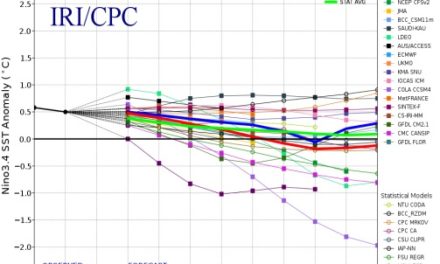
Weather overview and short-term outlook to Wednesday 10 March 2021

Visual: Probabilistic rainfall forecast for southern Africa for March, April and May. The forecast was released about a week ago.
Source: International Research Institute for Climate and Society, part of the Earth Institute at Columbia University in New York.
https://iri.columbia.edu/climate/forecast/net_asmt_nmme/2021/feb2021/images/MAM21_Afr_pcp.gif
Recent Developments
Given the dry spell of the past decad and the low rainfall expectations for the next ten days, it provides some perspective to see what leading meteorological experts have to say about our medium-term prospects.
This week’s visual comes from a highly regarded institute and it is interesting to note that the forecast is described by its compilers as a multi-model probability precipitation forecast. Digging a little deeper into their methodology, it transpired that the forecasts are based mostly on NOAA data.
NOAA (National Oceanic and Atmospheric Administration of the US Government) is the number one authority on weather anywhere in the world.
In short, the forecast shows that, based on probabilities there is roughly a 40% chance for above normal precipitation over about two thirds of Namibia, excluding only the coastal plain below the escarpment, and about a 50% chance for above normal precipitation for the central northern areas and south-western Angola. The key phrase here is above normal, and that implies above normal for the specific season, i.e. March, April and May.
In this regard, one has to keep in mind that the next three months is the winding down period of the Namibian summer rainfall season. So when a forecast indicates probabilities for this specific period, it does not mean above what is normal for the main rain season, i.e. December, January and February, it only refers to this time of the year.
It is advisable to click on the link above to see the forecast for the entire continent because a very interesting feature comes to the fore. Similar conditions are predicted for western Tanzania and northern Zambia and this provides an extremely important clue for what we may reasonably expect over the next three months.
The so-called Indian Ocean Transport is a broad conveyor of moisture running more or less from the northern tip of Madagascar up to the equator, in a westerly direction from the ocean onto the continent. In 2019, the main problem was not local conditions but the state of the atmosphere over western Tanzania, northern Zambia and northern Mozambique. The atmosphere was “fragmented” and the Inter-tropical Convergence Zone failed to develop over this area.
In essence, the channel that moisture follows from the Indian Ocean into central Africa and from there to Angola and then to us, was broken, resulting in the drought. Going by what Columbia’s experts are expecting, that channel is now intact, meaning there is no reason why it cannot remain active late into the season, even into early winter.
On the Radar
Not much will change over the weekend. Current conditions will continue. The mornings will be clear with intermittent cloud starting to build during mid-morning, and by late afternoon, there is an outside chance of a thunder shower here or there, (in places, as the local met is fond of saying).
This type of development has been seen on satellite images for the past week. It was noticeable that it happened every day, and that it covered more or less the same area, i.e. the Namibian interior east of the escarpment.
By Tuesday afternoon there is a fair amount of instability in the middle layers of the atmosphere with very little high pressure control in the upper layers. This may be conducive to light showers over the northern two thirds of the country, only excluding Hardap and Karas.











































